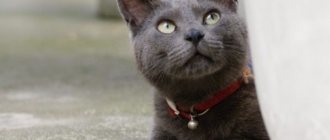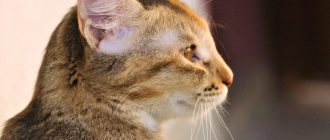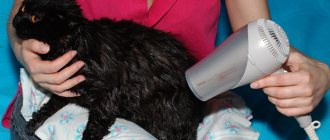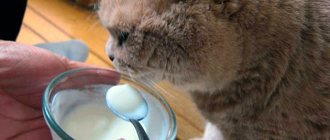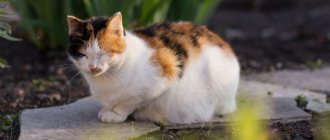Trainer Yu. Kuklachev created a “School of Education” for cats, but excluded mentoring and violence from it. Yuri Dmitrievich encourages his colleagues to love and study furry students. Over the course of 40 years of work, the chief cat expert in Russia has accumulated 4 boxes of diaries of observations of them.
But age-old folk wisdom encourages “stick” methods for educational purposes. “Just show the beaten cat the vine,” says the Russian proverb. So is it possible to punish a cat? Is corporal punishment acceptable in relation to the most sensitive and sophisticated mammal? Let us turn to the opinion of animal psychologists.
You can't drag a cat by the tail
Cats should not be pulled or pulled by the tail. Categorically! But this is problematic when there are small children in the house. Very often they play with their pet this way. Therefore, we need to explain to them that this cannot be done. Why?
The thing is that the tail is part of the cat's spine. We all know from school how important the spine is for a person and how dangerous its damage is. Naturally, it is also dangerous for animals to damage it.
The tail contains a lot of nerve fibers, which are a continuation of the spinal cord. Just like in humans, vertebrae can be displaced relative to each other or even broken. Just imagine what will happen then! The cat can even be paralyzed.
The inner world of a domestic cat
The domestication of the furry predator began 9.5 thousand years ago. But even today he behaves as if he is patronizing a person. Cats tend to become attached to the house and owners and establish emotional contact with them. However, they easily return to a wild lifestyle.
Unlike a dog, a cat has not lost the habits of its distant ancestors and has retained the independence of a lone predator. Scientists say: genetically she has not changed. This cannot be ignored when solving the problem of how to punish a cat.
Why does a cat not let a cat near her during heat: reasons
Physiology is designed in such a way that the pet allows mating only during estrus. The optimal time for fertilization is considered to be the period between the third and fifth days of estrus. It is at this time that ovulation occurs. Therefore, animals should be brought together for mating on the second day.
They will get used to each other. The first mating stimulates the movement of the egg from the ovary towards the uterus. The signal is the pain that the female experiences when the cat removes its rough genital organ. In one of the next intercourse, conception occurs.
However, for the following reasons, the cat does not allow the cat to approach, behaves aggressively and mating does not occur:
- Owner's error. The acquaintance between the couples took place too late, when ovulation had already occurred. In such a situation, a fight cannot be ruled out.
- Mating in the female's territory. Moving and finding yourself in an unfamiliar environment leads to stress. A cat can more easily tolerate the adverse effects of change, but a cat feels insecure in a foreign land and does not show persistence. The female does not like it when her suitor does not pay due attention. At the first unsuccessful experience, the cat becomes depressed and stops harassing.
- The cat didn't like the male. She falls to the side, hisses and scratches.
- They forgot to feed the female. She may not like the food the cat eats. Therefore, you should take granules from home that your pet is accustomed to eating at home. The best option is to find out from the cat’s owners what they feed it and switch the cat to the same diet.
- There is a big difference in live weight and age. The biggest problem occurs when the female is larger than the male. But the opposite situation can also prevent mating.
- Inexperienced cat: It is not advisable to bring virgins together. The giving birth cat is tasked with untying the male. The partner for a pet that is being bred for the first time must have sexual experience and be older than her, but not much.
- The pet got sick. A slight malaise, which is difficult to notice, may serve as a reason to refuse mating.
The biggest problems arise during the first mating. If something goes wrong, the cat will have a nervous breakdown, which will worsen during subsequent matings.
Cautions
Another reason why hitting a cat is absolutely forbidden is its vulnerability. Namely :
- Cats are small and their bodies are fragile; if we do not calculate our strength, we can cripple them. Under no circumstances should you hit a cat on the head - this will cause a concussion with all the attendant negative consequences.
- You also need to be careful with the area where the spine meets the tail. For a cat, this is a very sensitive area, similar to our solar plexus - there are many nerve endings there. Hitting this place means causing very severe pain.
- Take care of your pet’s mental health - if a cat is frightened and beaten, it will get used to living in constant fear. This will cause many problems that are very similar to human ones. Scientists have proven that animals can also experience post-traumatic disorders, they can suffer from depression or panic attacks. But, unlike people, cats have no one to help them cope.
"Crimes" and punishments
One can only adapt to the habits of semi-domesticated “dwarf lions”. The main principle of education is not to suppress, but to satisfy the needs of a willful animal. Otherwise, the cute kitten will turn into a secretive and vengeful beast. Let's consider the typical offenses of meowing pets and competent methods of “re-education”.
How to punish a cat if she shits
An animal must be toilet trained from the first day it arrives in the house. It’s better to buy two trays: cats prefer to go to different places when they need to be small and big. Every time after eating, it is recommended to take the kitten to the toilet and reward it for correct behavior.
A serious mistake is using newspaper as a filler. It is not able to absorb moisture, and the cat’s wet paws will carry specific odors throughout the house. This will inevitably lead to hygienic disorientation of the animal and conflicts with the owners.
How to properly punish a cat in this case? The usual method - “poking with the snout” - will only add to the problems. The pet will understand it in its own way: “That’s right, continue to act this way.” If you add “spanking” to “poking,” fear and resentment will settle in the cat’s soul. Productive ways to solve the “toilet” problem are obvious: changing the filler and/or moving the tray to a place that is comfortable for the cat.
In relation to an adult mischief maker, it is recommended to use different tactics. You should start from understanding the reason for what is happening. When fauna children mark territory, they are claiming leadership. Therefore, the cat must be made to understand: the dominant role in the house belongs to the person.
It is important to catch the miscreant at the “scene of the crime”, lift him by the scruff of the neck and look intently into his eyes (according to the cat’s rules: whoever doesn’t look away wins). It is advisable to reinforce the psychic attack with a threatening hiss and imitation of a cat's finger strikes on the muzzle of the mustache.
Then the owner of the animal must “interrupt” the cat’s marks with human ones: wash the puddle and wipe the floor with his own sweaty T-shirt or splash his favorite toilet water.
How to punish a cat for aggression
The unfriendly attitude of the meowing companion will be “told” by the ears pressed to the head, the fluffy or nervously tossing tail.
We list common reasons for cat aggression and ways to eliminate them:
- Malaise. The cat may be bothered by tooth or joint pain, stomach upset, or nausea. Medical attention is definitely required here.
- Emotional deviations. Premature weaning from its mother and siblings results in the kitten’s inability to self-control. You should not separate your baby from the family until he reaches the age of 2-2.5 months.
- Fear of human hands. The phobia is inherent in street “foundlings” and kittens not accustomed to affection. Adaptation of the “savage” will require time, patience and tact.
- Defending the right to personal space. Cats quickly get tired of games and cannot stand intrusiveness and noise. They should have “their own corner” - a secluded and safe area (under a chair, on a windowsill, in a playhouse) where they can hide, retire, and relax.
- Manifestation of the hunter's instinct. The natural state of a predator is to overtake and attack fleeing prey. To avoid thinking about how to punish a cat for scratching, you should not use your own hands and feet as teaser toys. The animal must clearly understand: the human body is not a scratching post. If the cat is used to grabbing legs or arms, you should not fuel his excitement with screams and lamentations. Punishing a predator for its hunting instinct is nonsense. You should switch the animal's attention to inanimate objects: balls, laces, ribbons with a tied bow. At first, to avoid scratches, you will have to trim your nails regularly.
- Longing for the “bride/groom”. It is not punishment that will help extinguish a cat’s sexual behavior, but a civilized solution - castration or sterilization.
- Jealousy of the cubs. You shouldn’t hold a “watch” or pick up newborns if the mother cat is against it. Over time, she will warm up and share her squeaking “treasure” with her owner.
Scientists have discovered how to properly pet cats
According to public perception, cats value independence more than other pets. However, people often do not give them enough freedom and are met with an aggressive reaction from their pets. Thanks to the results of various scientific publications, Lauren Finka, a research fellow at Nottingham Trent University, wrote a column on how to properly pet cats.
Many of us have encountered that friendly cat who seems to enjoy our petting for a minute, and then bites and fights. In such cases, it is very easy to blame the animal for everything, but most likely it is our fault - we are simply stroking it incorrectly.
To understand what is happening, you first need to know a little more about the pedigree of cats. It is likely that the ancestors of the domestic cat (the African wild cat) were viewed by people solely as a means of pest control, but attitudes towards modern cats have changed greatly - we have come to consider them valuable companions and even our fur babies.
It is believed that this shift in the relationship between humans and cats occurred about 4,000 years ago (not long after the dog acquired the status of man's best friend). While this amount of time may seem like enough time for a species to fully adjust to increased social demands, the passage of centuries is unlikely to make any difference to your feline friend. Additionally, domestic cats show relatively modest genetic divergence from their ancestors, meaning that domestic cats have the same mentality as wild cats.
African wild cat. Source: shutterstock.com
Humans, on the other hand, are a social species. We prefer closeness and touch to show affection. In addition, we are attracted to infantile facial features - large eyes and forehead, small nose and round face. This is why many of us find cat faces so cute. It's no surprise that our initial reaction when we see a cat or kitten is to pet and hug the animal. But it also shouldn't be surprising that many cats can find this type of interaction overwhelming.
Cat sympathy
Although many cats love to be petted and will choose us over food in certain cases, human interaction is something they must learn to enjoy during their relatively short sensitive period: between the second and seventh weeks of life.
When it comes to human-cat interactions, the characteristics of humans are also important. Our personalities and gender, the areas of a cat's body we touch, and how we act around cats in general can all play an important role in how a cat responds to our affection.
And while some cats may respond aggressively to physical attention, others may simply tolerate our social advances in exchange for care (food and shelter). However, a tolerant cat is not necessarily a happy cat. Higher levels of stress are reported in cats that are described by their owners as tolerant of petting.
How to pet a cat correctly
The secret to the technique is to give the cat as much control as possible during the interaction. How much to pet, for how long, whether they want attention at all - the animal should have all these choices.
Due to our tactile nature and love of cute creatures, this approach may not come instinctively. For some it will probably require self-restraint. But it can pay off: Research shows that interactions with cats are likely to last longer if the cat rather than the person initiates it.
It is also very important to pay close attention to the cat's behavior and posture during interactions to ensure their comfort. When it comes to touch, less is more. This is true for communication with both the veterinarian and other people.
As a general guide, most friendly cats will enjoy touching around the areas where their facial glands are located: the base of the ears, under the chin and around the cheeks. These areas are usually favored over areas such as their belly, back, and base of the tail.
Signs of pleasure in a cat:
- holds tail vertically and selects it to initiate contact;
- purrs and touches a person with its front paws;
- gently swings tail from side to side;
- assumes a relaxed posture, ears perked up and directed forward;
- gently pushes the person's hand if he stops petting the cat.
Signs of hostility or tension in a cat:
- displaces, moves or turns his head away from you;
- remains passive (does not purr, does not rub);
- Blinks exaggeratedly, shakes head or body, licks nose;
- quickly begins to lick himself;
- Rippling or twitching of the skin, usually along the back;
- the tail begins to beat or knock;
- ears flatten to the sides or rotate backwards;
- turns his head sharply and suddenly towards you or your hand;
- bites, hits or smacks your hand with its paw.
Whether it is appropriate to call cats "fur babies" is a controversial issue open to debate. Some cats love to be touched, others don't, and many tolerate it at best. Ultimately, when it comes to cats, it's important to respect their boundaries and the wild cat within, even if you have to coddle them from a distance.
Lauren Robin Finka works as a consultant at Battersea Dogs and Cats Home and also writes a monthly column for Your Cat magazine. The original material is available here.
Why you can't drag a cat by the scruff of the neck
Thanks to the innate reflex, the kitten, when the mother cat drags it, grabbing it by the scruff of the neck, relaxes its body, and also tucks its hind legs and tail. Temporary paralysis is explained by pinching of a bundle of nerves located on the back of the neck. It is much easier for a cat to move a relaxed and non-resisting baby to a safe place. During carrying, the cat does not cause any harm or pain to its cub. The scruff of a cat's neck is considered the most painless part of the body. However, adult pets cannot be lifted or dragged by the scruff of the neck.
Cats drag kittens, biting the scruff of the neck with their teeth
Reasons are physiological
The ban on lifting an adult cat by the scruff of the neck is explained by physiology:
- A mature animal's skin is rougher and less elastic than that of a small kitten. The skin does not stretch well and may even tear.
- The neck muscles may become damaged (stretched or torn), since the pet is already quite heavy.
- The rough skin becomes very tight and puts pressure on the throat, making it difficult for the cat to breathe.
- A sharp grab by the scruff of the neck can even damage the spine (in rare cases).
In an unusual position, some individuals panic, break out and scratch themselves badly. At the same time, they cause physical harm not only to the person who grabbed them, but also to themselves.
In principle, it is impossible to take a big cat by the scruff of the neck.
Our previous cat was small and puny. He was constantly playing dirty tricks, and that’s why they often dragged him by the scruff of the neck. This did not cause him any visible suffering. The current cat is distinguished by good quality and fatness. It is not easy to grab her by the scruff of the neck, and besides, these actions clearly cause severe pain to the cat.
Reasons are psychological
From a psychological point of view, the consequences of grabbing by the scruff of the neck can be as follows:
- the pet will be very frightened and then will not approach the owner, and sometimes even people;
- when a cat is taken by the scruff of the neck, he becomes helpless and weak-willed, which is a huge stress for him;
- a timid animal after such violent actions will try to escape from the house at the first opportunity;
- an offended cat will perceive pulling by the scruff of the neck as an undeserved punishment that may not be forgiven;
- a self-sufficient cat will feel humiliated and lose trust in its owner.
In this position, the cat feels unprotected and it makes him angry.
